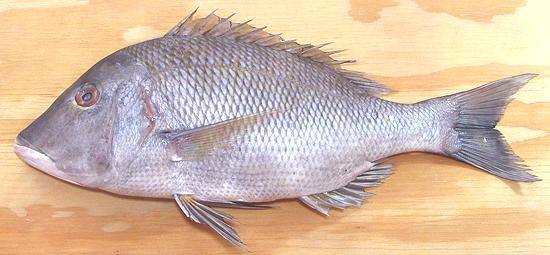 [Lethrinus lentjan]
[Lethrinus lentjan]
This Indo - West Pacific fish is found from the eastern coast of Africa through the South Pacific islands, and as far north as Taiwan. The most commercial of the Emperors, this fish can grow to 20 inches, but the photo specimen was 16 inches long and weighed 1 pound 15-1/4 ounces. This fish tends to olive on the upper body and lighter below, but adopts various other color schemes and patterns. "Pink Ear" comes from the variable size slash of red at the back edge of the gill cover. This fish is IUCN Red List rated NE (Not Evaluated), and is not considered threatened.
More on Varieties of Fish (very
large page).
Pink Ear Emperor has a mild but distinctive flavor I find quite likable. Important: this fish can not be casually substituted for other fish in most recipes, save perhaps for Monkfish. It cooks up very firm, almost chewy, and is difficult to flake apart on the plate. I have steamed a whole fish (head off) and it was certainly edible, but a little tough to break up. Reserve this fish for recipes that require firm fish that doesn't break up with wet cooking, such as soups and stews.
Buying: This fish appears now and then in the Asian markets here in Los Angeles, but is often mislabeled. The photo specimen was sold as "Emperor Snapper" (it is not a snapper) at 2016 US $2.99 / pound at a Philippine market in Los Angeles (Eagle Rock). The previous ones I bought were sold as "Silver Porgy", which it is not.
Scales: This fish is completely covered with stiff medium size scales with fairly good adhesion. They take a little energy to scrape off and fly around a lot.
Cleaning The innards are clean and orderly compared to some fish, but take a little effort to clean out well. The esophagus is tough and must be cut with shears, and there are a number of strong membranes that need pulling. Your long nose pliers can help here. The gills pull fairly hard, and there's some junk in the throat that doesn't come out until the gills are pulled. Since I don't generally use the head of this fish, I just cut it off and discard it, which makes cleaning much easier.
Fillet: This is a pretty easy to fillet fish with a coherent fin-bone structure, except at the rib cage. The ribs pull hard and tear up the flesh, so I recommend just shaving the fillet off the ribs, rather than cutting them loose. This is also a bit of a problem because the ribs project out horizontally from under the backbone for 1/4 to 3/8 inch before they turn down. This makes shaving the fillet off a bit more difficult than usual. There are nasty centerline pinbones to pull for a little more than the length of the body cavity, and they tear the flesh also.
Skin: Skin shrink is moderate, and the skin has no strong or off flavor. Skin-on fillets can be pan fried fine. When you turn them skin-side down, just hold them flat with your turner. In a few seconds the skin will soften and the fillet will remain flat. I have poached skin-on half fillets. They curl fairly severely, but in a minute or two the skin relaxes and the return almost to flat. Set a poached fillet on a plate, skin side down, and it will be flat. If desired, fillets can be skinned using the usual long knife and cutting board Method.
Yield: Yield is moderate, with two fish weighing a total of 3 pounds 11 ounces yielding 28 ounces of skin-on fillet (47%). Skin-off would be 24.9 ounces (42%).
Stock: The heads, fins and bones, simmered or 40 minutes, make a slightly murky stock with a distinctive flavor I don't care that much for - not recommended.
sf_emperpz* 061224 r 160521 - www.clovegarden.com